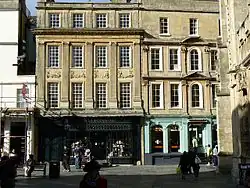Marshal Wade's House
Marshal Wade's House at 14 Abbey Church Yard, Bath, Somerset, England was built around 1700 and has been designated as a Grade I listed building.[1]
| Marshal Wade's House | |
|---|---|
 | |
| Location | Bath, Somerset, England |
| Coordinates | 51°22′53.5″N 2°21′34.2″W |
| Built | c. 1700 |
Listed Building – Grade I | |
| Designated | 12 June 1950[1] |
| Reference no. | 442123 |
 Location of Marshal Wade's House in Somerset | |
The building was originally attributed to Lord Burlington and thought to have been built in 1730, however it is now thought to have been an earlier construction,[1] for George Wade who was a Field Marshal and served as a British military commander and Commander-in-Chief of the Forces, as well as Member of Parliament for Bath from 1722 to 1747.
The Palladian nature of the architecture is emphasised by the 5 fluted Ionic pilasters on the first and second floors.[1] Furthermore, the building uses standard Georgian period sash windows with multiple panes and a moulded cornice. The construction was inspired by Inigo Jones' house in Covent Garden, London.[2]
The shop on the ground floor was an early 19th-century development which is now occupied by the National Trust.[3] The ground floor was converted to retail use and has a Regency era shopfront which includes an elaborate fascia and delicate Regency trimmings.[2]
The house was acquired by the Landmark Trust in 1975 who have carried out various renovation work and now let out the property.[4] The ground floor is currently in retail use and is open to the public. However, the upper levels offer no public access.[2]
References
- "Marshal Wade's House". Images of England. English Heritage. Archived from the original on 17 October 2012. Retrieved 25 July 2009.
- Dargan, Pat (2018). Bath in 50 Buildings. Amberley Publishing. ISBN 9781445659640.
- Greenwood, Charles (1977). Famous houses of the West Country. Bath: Kingsmead Press. pp. 93–95. ISBN 978-0-901571-87-8.
- "Marshal Wades House". Landmark Trust. Archived from the original on 7 July 2012. Retrieved 25 July 2009.